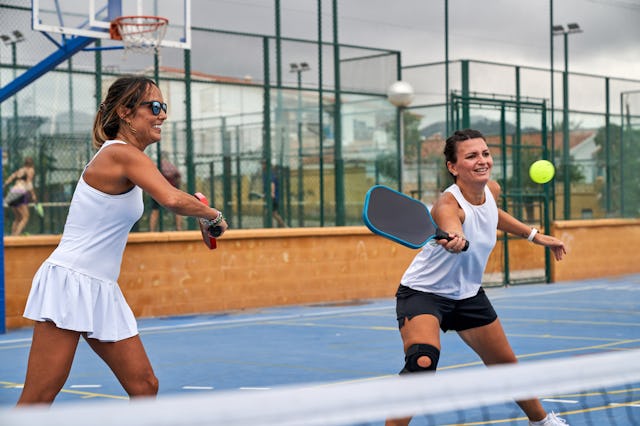When You Get Tired Of Being The Only Person Who Hasn’t Tried Pickleball, Here’s Your Guide
Pros share what to know before you hit the pickleball court.

It’s not just you; these days, it seems like everyone is obsessed with pickleball. The tennis-badminton-ping-pong hybrid had been seeing a resurgence prior to the pandemic, and then (ahem) spiked in popularity as people looked for new ways to get outside and stay social in 2020. Now, it remains the fastest-growing sport on the block, with more than 50,000 known pickleball courts across the country for families and friends to practice their serve.
Though traditionally associated with the post-retirement set, pickleball is fun for all ages, which means you can bring the kids and the grandparents out on the court to hit some balls together. Here’s what an expert says you should know before you play pickleball — in case you get tired of being the only person in your circle who hasn’t tried the trend.
You know what they say: If you can’t beat ’em, join ’em.
Why Is Pickleball So Popular?
As Noe Sariban, PT, DPT, Cert. DN, explains, “Pickleball has a low barrier for entry: It is inexpensive to play with many public courts available, and entry-level equipment is reasonably priced. It is also very easy to learn, and anyone — even without an athletic background — can learn to play and have fun within 10 minutes.”
How Do You Play Pickleball?
In a typical pickleball game, two teams of two volley back and forth with a small, wiffle-like ball and paddle back and forth over a net. Given that it requires less movement than tennis, it’s generally more accessible than some other court sports out there. “Pickleball can be as intense as one wants to make it based on their athletic ability and how much of a workout they want to do,” says Sariban, who is a pickleball instructor, former pro player, and physical therapist. “Doubles requires less movement, and singles is very intense.”
If you’re serious about perfecting your swing, Sariban recommends enlisting the help of a pro who can teach you proper form. Pickleball lessons will help you “learn the game properly and have a better understanding of the movement required to play pickleball,” he says, adding, “I would spend money on top quality instruction from someone who really understands the game and the biomechanics involved in order to develop properly and learn the game over spending money on products or accessories.”
Is Pickleball Good Exercise?
With less ground to cover and matches at a typically slower pace than other racket sports, it’s clear why so many are becoming pickleball devotees. Still, it is a full-body workout, as Heather Milton, a clinical exercise physiologist at the Sports Performance Center at NYU Langone Health, told The New York Times.
“Because the paddle’s so small, pickleball is great for hand-eye coordination as well as neuromuscular coordination,” Milton said. “You’re moving in different planes, not just forward like you do when you’re walking or cycling, which is good for your agility. And because there’s rotation involved, you’re working your core along with your upper and lower extremities.”
What Could Go Wrong?
Any new activity brings a risk of injury, so how can you ensure all players stay safe while having fun?
As with any sport, it’s best to ease into it, as most pickleball injuries are from strain or overuse, as Christopher Wu, M.D., a sports and internal medicine physician at Atlantic Health System, told the American Medical Association (AMA). Plus, the lunging, swinging, and quick stop-starts can contribute to accidental slips, trips, falls, and dives. But in most cases, doctors see patients who’ve ramped up their activity too quickly, not giving their bodies time to heal and adjust, as Wu explained.
“Overuse injuries would be shoulder or knee pain that develops over time — there’s not really one specific moment or movement where you can say, ‘Ow, that hurt,’” he said. Of course, acute injuries, such as a sprained ankle or a pulled hamstring, can occur even in experienced players. Any sort of pain should be checked out, especially if you see swelling, redness, bruising, or any other signs of acute injury.
Dynamic stretching (think squats, arm circles, walking lunges) before hitting the court can help warm your body up, and hydration is crucial, especially if the temps outside are sizzling.
Also, your shoe of choice can help make or break your pickleball game. “One of the biggest things I see new players make mistakes with is their footwear,” says Sariban. “Not wearing proper hard court shoes (shoes made for hard tennis courts) is a great risk factor for falling. The court surface is very gritty, almost like sandpaper, and the rubber on the bottom of regular sneakers is not stiff enough to handle this surface. By wearing proper shoes, people would significantly decrease their risk of falling and therefore reduce injuries.”
Where Can You Start?
Pickleball can be played indoors or out, standing or in a wheelchair, and finding a court has never been easier, thanks to the Pickleball+ app. You can also enter your zip code into the USA Pickleball Association’s court locator website.
And yes, you can get super cute pickleball gear, but any USAPA-approved pickleball set with paddles and balls will do. Grab your gear and say buh-bye to summer boredom.